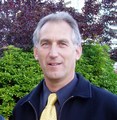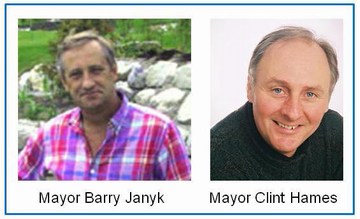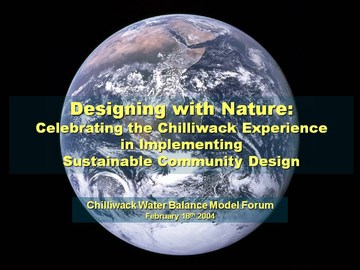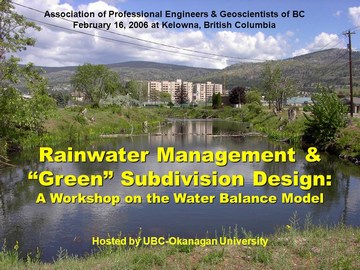Chilliwack, Surrey, Kelowna and Courtenay: Four cities in four regions of British Columbia were early adopters in embracing the Water Balance Model
Note to Readers:
The following story about Water Balance Model early adopters is extracted from Chapter 5 of Beyond the Guidebook 2010, released in June 2010. This water-centric guidance document tells the stories of how change is being implemented on the ground in British Columbia. To download a PDF copy of the article below, click on Early Adopters: Chilliwack, Surrey, Kelowna and Courtenay
Early Adopters
Four cities in four regions – Chilliwack (Fraser Valley), Surrey (Metro Vancouver), Kelowna (Okanagan) and Courtenay (Vancouver Island) – were early adopters in embracing the ‘design with nature’ paradigm-shift and were Water Balance Model founding partners in 2002. Also, Chilliwack and Surrey were original members of the Inter-Governmental Partnership steering committee. All four played key roles in helping to deliver early outreach.
During the two-year period preceding release of Stormwater Planning: A Guidebook for British Columbia in 2002, three of these cities – namely Chilliwack, Surrey and Kelowna – each contributed case study experience that facilitated development and verification of the water balance methodology.
Launch of WBM in 2003
“The City of Kelowna assisted with the rollout of the Guidebook and pre-launch of the WBM in Spring 2003 in communities such as Penticton and Prince George,” recalls Ted van der  Gulik, Chair of the Inter-Governmental Partnership (IGP) that developed and maintains the Water Balance Model.
Gulik, Chair of the Inter-Governmental Partnership (IGP) that developed and maintains the Water Balance Model.
“The participation of the City’s Alan Newcombe (Drainage Manager) in our road show added credibility; and City case study experience provided on the ground examples that reassured participants about the paradigm-shift.”
“The WBM pre-launch created awareness and interest that led UBCM to provide the IGP with a platform for the formal launch of the WBM at their September 2003 Annual Conference. The support of two mayors was key: Mayor Barry Janyk of the Town of Gibsons and Mayor Clint Hames of Chilliwack were the WBM champions.”
“Mayor Janyk, Dipak Basu (City of Chilliwack) and Kim Stephens tag-teamed to tell the WBM story at the UBCM Urban Forum. Dipak provided the core content; he showcased Chilliwack examples.”
To Learn More:
To download a PDF copy of the 2003 presentation to UBCM, click on Designing with Nature – Walking the Talk for Sustainable Community Design (16MB)
To learn more about the role played by Mayor Barry Janyk, click on A Look Back to the SmartStorm Forum Series: Genesis for the Water Balance Model.
When the SmartStorm Forum Series introduced the term ‘smart development’ a decade ago, the goal was to advance implementation of an integrated and balanced approach to land use. To learn more, click on A decade ago the SmartStorm Forum Series set in motion a chain of events that are still reverberating in British Columbia

WBM Forums in 2004
“Chilliwack and Surrey each hosted a forum in early 2004. The objective of the forums was to foster broad-based provincial support for commonsense improvements in rainwater management practices at the site level,” continues Ted van der Gulik.
“Led by Dipak Basu, the Chilliwack Forum was designed to help stakeholders in the Eastern Fraser Valley understand what ‘thinking outside the pipe’ and ‘designing with nature’ actually mean on the ground.”
“Led by Rémi Dubé, the Surrey Forum was part of the City’s commitment to providing green infrastructure leadership. The Forum provided the City with an opportunity to report out on the East Clayton Sustainable Community.”

WBM Events in Thompson-Okanagan
“In 2005, the City of Kelowna (John Vos) was the catalyst for a series of events that broadened the reach of the WBM. First, the City connected us with the EMCO Corporation (Keith Lumby). This industry collaboration provided us with access to a new audience when EMCO organized a trade event in Kelowna. Success led to an event in Kamloops,” states Ted van der Gulik.
“Capitalizing on the momentum created by this success, the City and APEGBC jointly sponsored a WBM seminar. In turn, this set the stage for 4-way collaboration with UBC- Okanagan. Thanks to Bernie Bauer, we held a training workshop at the university in February 2006. This reinforced the early support that the City’s John Vos provided.”
Okanagan. Thanks to Bernie Bauer, we held a training workshop at the university in February 2006. This reinforced the early support that the City’s John Vos provided.”
Bernie Bauer is Dean of Arts and Sciences at UBC-Okanagan, and is currently Acting Director of the Okanagan Sustainability Institute. He is also Chair of the Okanagan Water Stewardship Council.

Beyond the Guidebook 2010
“In October 1997, a focus group workshop convened by UBCM set in motion a chain of outcomes that culminated in Stormwater Planning: A Guidebook for British Columbia. This was a catalyst for change that has resulted in British Columbia achieving international recognition as a leader in implementing green infrastructure,” recalls Ted van der Gulik .
“Beyond the Guidebook 2010 is the story of what has been accomplished on the ground over the past decade. It demonstrates that the practitioner culture is changing as an outcome of collaboration, partnerships and alignment. It also provides local governments with ‘how to’ guidance for developing outcome-oriented urban watershed plans.”
City of Kelowna Perspective
 Beyond the Guidebook 2010 is advancing an holistic approach to sustainable water management. Topsoil in particular is the point of connection between Drought Management and Rainwater Management.
Beyond the Guidebook 2010 is advancing an holistic approach to sustainable water management. Topsoil in particular is the point of connection between Drought Management and Rainwater Management.
“Since I have been advocating for improvements to our watersheds I have witnessed many groups in the Okanagan working together in developing a clear plan for water sustainability,” states Mayor Sharon Shepherd in providing her perspective on Beyond the Guidebook 2010.
“It is essential that we continue to promote the efficient use of water using the best conservation techniques and at the same time strengthen local and provincial environment policy that would protect the very important watersheds that are under constant pressure for other uses.”
To Learn More:
Click on UBCM Annual Convention provides platform for rollout of ‘Beyond the Guidebook 2010’ — “We will use this coming together of BC’s local leaders to share and learn from each other’s experiences, and gain ideas to move our own communities forward,” states  Harry Nyce, President of the Union of BC Municipalities.
Harry Nyce, President of the Union of BC Municipalities.
To download a copy, click on Beyond the Guidebook 2010: Implementing a New Culture for Urban Watershed Protection and Restoration in British Columbia



